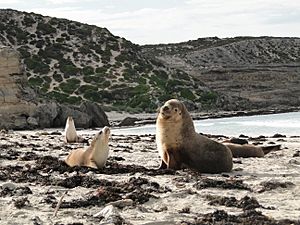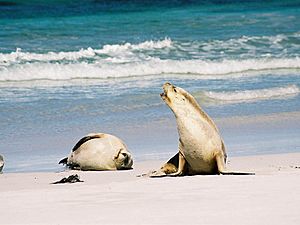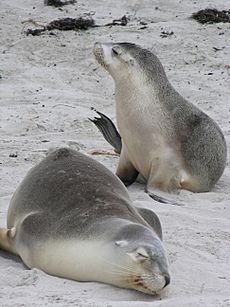Australian sea lion facts for kids
Quick facts for kids Australian sea lion |
|
|---|---|
 |
|
| Male Australian sea lion with a harem at Seal Bay Conservation Park, Kangaroo Island, South Australia | |
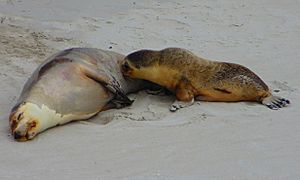 |
|
| Female Australian sea lion with pup at Seal Bay Conservation Park, Kangaroo Island, South Australia | |
| Conservation status | |
| Scientific classification | |
| Genus: |
Neophoca
|
| Species: |
cinerea
|
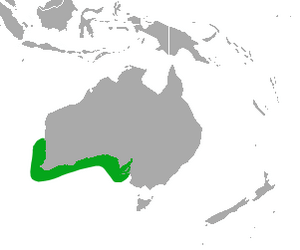 |
|
| Australian sea lion range | |
The Australian sea lion (Neophoca cinerea), also known as the Australian sea-lion or Australian sealion, is a species of sea lion that lives only in Australia.
With a population estimated at around 14,730 animals, they've been listed as endangered.
Contents
What do they look like?
Male sea lions are bigger than the females. They are dark brown with a yellow mane while females are silver or fawn with a cream-colored tummy. They have short fur to keep them warm. They use their flippers to swim fast in the water and to walk on land.
Size
Male Australian sea lions can grow to be about 2.0 to 2.5 meters (6.6 to 8.2 feet) long. They can weigh between 250 to 300 kilograms (550 to 660 pounds)! That's about as heavy as a baby elephant!
Female Australian sea lions are smaller than the males. They usually grow to be about 1.3 to 1.8 meters (4.3 to 5.9 feet) long. They weigh between 65 to 105 kilograms (143 to 231 pounds).
Where do they live?
These sea lions are found on the southern coast of Australia from the Houtman Abrolhos Islands in Western Australia all the way to The Pages Islands in South Australia. They mostly live on islands, but sometimes they visit the mainland, like at Point Labatt in South Australia.
A long time ago, they used to live in more places, but now they don't live as far out as they used to.
How do they communicate?
Females and their pups have special ways of knowing who is who. They use their sense of smell, sight, and hearing to recognize each other.
Male Australian sea lions produce three different call types: a barking call, a bleating call, and a female-like call.
Diet
Australian sea lions prey on teleost fish, squid, cuttlefish, octopus, sharks (including Port Jackson sharks), Southern rock lobster, other small crustaceans and Little penguins.
Predators
Adult Australian sea lions are eaten by Great white sharks and are occasionally killed by other animals such as stingrays. Pups are vulnerable to attack by other smaller shark species.
Breeding behaviour

The duration of the breeding season can range from five to seven months and has been recorded for up to nine months at Seal Bay on Kangaroo Island.
Bulls do not have fixed territories during the breeding season. The males fight other males from a very young age to establish their individual positions in the male hierarchy and during the breeding season, dominant males will guard females for the right to breed with her. Male Australian sea lions are also known to kill young as an act of defence of territory.
Australian sea lions also practice alloparental care, in which an adult may adopt the pup or pups of another. This might take place if the original parents die or are for some reason separated from them. This behaviour is common and is seen in many other animal species such as the elephant and fathead minnow.
Population
In 2010, an estimated 14,730 Australian sea lions existed. By 2014, the population had dropped to an estimated 6,500 and continues to decrease. The population is listed as Endangered on the IUCN Red List of Threatened Species. The Australian sea lion population is naturally disadvantaged when compared to other pinnipeds in Australia. Its long and complicated breeding cycle, the high site fidelity of females, and high mortality rates all make the species more vulnerable to extinction.
Jones Island , west of Eyre Peninsula in South Australia is one of the few sites where the population is not decreasing. In 2019, it was declared a "prohibited area" to eliminate human disturbance to the colony while landed.
In 2018 it was reported that aerial drones were being used to successfully discover and measure colonies of Australian sea lions along the Nullarbor Plain. Previously, surveying these areas was limited to the use of binoculars and peering down 60 metre high cliffs to view the rocks below.
Threats
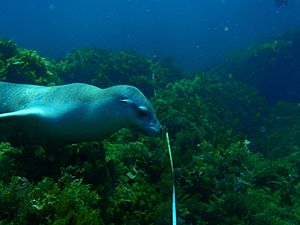
Sea lions were heavily hunted following European settlement which greatly reduced their numbers. Large-scale hunting ceased in the 1920s, but some killing and trade in "hair seal" skins continued. No baseline population data exists, but the species population and range have both decreased.
Major threatening processes in the 20th and 21st centuries were primarily interactions with commercial fishing gear and illegal shooting. Entangled animals can sometimes be found and treated successfully.
Secondary threats include: marine fish aquaculture (including loss of habitat, entanglement and direct killing), disease, pollution, oil spills and noise, particularly from seismic surveys, construction, or marine operations.
Conservation status and management
The protection of breeding habitat for the Australian sealion has been a conservation priority since the early 20th century.
In 2005, the Australian sea lion was listed as Vulnerable under the Commonwealth Environment Protection and Biodiversity Conservation Act 1999 and is similarly listed in each state across its range (South Australia and Western Australia). On 11 June 2013, the Recovery Plan for the Australian sea lion (Neophoca cinerea) was adopted by the Minister for Sustainability, Environment, Water, Population and Communities. The plan considers the conservation requirements of the species across its range and identifies the actions to be taken to ensure its long-term viability in nature and the parties that will undertake those actions. In November 2014, the species was assessed by the International Union for the Conservation of Nature as Endangered.
| Jurisdiction | Legislation or Relevant List | Conservation Status | Population trend | Last assessed |
|---|---|---|---|---|
| Global | IUCN Red List of Threatened Species | Endangered | Decreasing | 2014 |
| Australia | EPBC Act 1999 | Vulnerable | 2005 | |
| South Australia | National Parks and Wildlife Act 1972 | Vulnerable | ||
| Western Australia | Biodiversity Conservation Act 2016 | Vulnerable |
Captive breeding
Some zoos and aquariums are participating in captive breeding programs. In 2006 it was reported that at least 41 pups had been born and raised in captivity since 1981. The species has been kept in aquaria since at least as early as 1965. In 2015, an Australian sea lion juvenile was captured at Bletchley near Strathalbyn in South Australia, and was going to be considered for holding in captivity.
See also
 In Spanish: León marino australiano para niños
In Spanish: León marino australiano para niños



